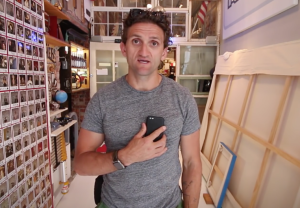Some of the wealthiest business men have dropped out of school at early ages. From Richard Branson (16) to David Karp (11) to even Benjamin Franklin (10) are included on this list and we all know that they turned out to be okay in life! Taso Du Val has just added his name to this prestigious list of early dropouts to riches. Taso Du Val is a software savant who has had a passion for technology from a very early age in his life.
Taso entered the workforce and joined a startup called Fotolog (business dealing with photo-sharing) as a lead engineer. After Fotolog was bought for $100 million in 2007 he joined another business startup as a lead engineer at Mark Levchin’s company (co-founder of PayPal) called Slide, which was bought by Google in 2010 for $228 million. Du Val, without a doubt, had some early luck and success landing prestigious positions in startups with not much of an academic background that gave him some key foundations for the challenges he will set out to accomplish in the future.
Du Val is currently helping other engineers land great jobs, as well as building his very own multimillion-dollar startup he helped co-found called TopTal. TopTal is based out of San Francisco and connects freelance software developers with businesses in need of programming expertise, rigorously screening applicants and making matches based on each client’s unique project demands and related factors like workplace culture.
Du Val’s story relates a lot to our class as our professor frequently stresses the concept of identifying a problem and thinking of a solution. Du Val recognized there was a problem and heard many complaints about the other players in the game and sought out to capitalize on it. There was a need and an opportunity that had yet to be met. Entrepreneurship cant exactly be taught and is hardwired into very few people. Some people are just naturally gifted with business smarts and others have to work harder to come by it.
The most important lesson to be learned by his story, no matter what your education or background is, just getting out there and doing it is the most important thing.









 A few years ago, Chase Adam was serving as a Peace Corps Volunteer in the Democratic Republic of the Congo when a woman boarded the bus and began asking for donations for her child’s medical treatment. Because panhandling is so prevalent in that area of the world, Adam was shocked to see all of the natives give the women money for her child. He realized the natives believed this woman because she had the child’s information and had established a sense of trust with them. Inspired, Adam returned to the United States with the goal of starting a non-profit to provide healthcare around the world.
A few years ago, Chase Adam was serving as a Peace Corps Volunteer in the Democratic Republic of the Congo when a woman boarded the bus and began asking for donations for her child’s medical treatment. Because panhandling is so prevalent in that area of the world, Adam was shocked to see all of the natives give the women money for her child. He realized the natives believed this woman because she had the child’s information and had established a sense of trust with them. Inspired, Adam returned to the United States with the goal of starting a non-profit to provide healthcare around the world.